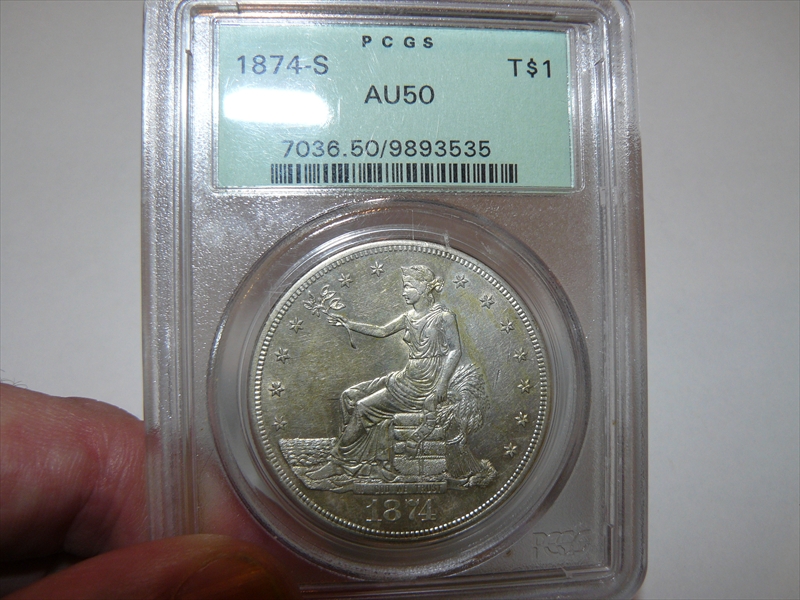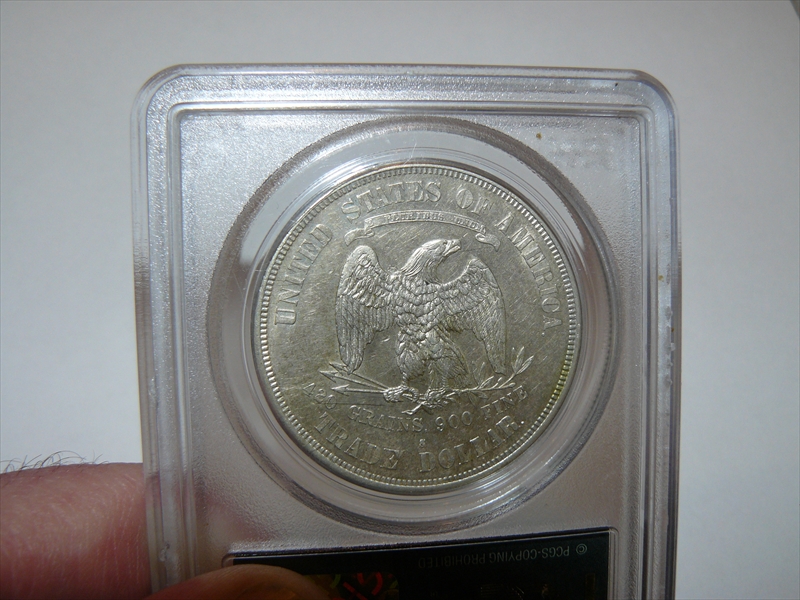1874-S T$1 AU50 认证号09893535, PCGS号7036
拥有者评论
1874-S Trade Dollar, PCGS AU50. Conservatively graded Old Green Holder (OGH), superior eye appeal, especially obverse. Paid $400 cash at Ft Washington coin show 1/27/2013. I already had one that I had purchased at eBay the year before, but I liked this one better
专家评论
Q. David Bowers
The following narrative, with minor editing, is from my "Silver Dollars & Trade Dollars of the United States: A Complete Encyclopedia" (Wolfeboro, NH: Bowers and Merena Galleries, Inc., 1993).Coinage Context
Large commercial demand: The year 1874 saw a great demand for trade dollars to be used in the China trade, and by the end of December some 2,549,000 coins were struck at the San Francisco facility, a record coinage which surpassed what had been done at all three mints the year before in 1873. With the exception of January, when no trade dollars were coined, and November, when 95,000 were struck, the mintage each month topped the 100,000 mark, hitting a high in May with 366,000 pieces.
True to the purpose for which they were coined, nearly all 1874-S trade dollars were shipped to the Orient. There they saw extensive service in commerce.
Numismatic Information
Circulated grades: Worn coins are moderately scarce but enough are around that examples are readily obtainable. In grades from VF-20 through AU-58 this is the most plentiful San Francisco Mint trade dollar (not including 1875-S/CC). Probably 2,500 to 5,000 exist.
Countless thousands of 1874-S trade dollars were chopmarked by merchants and bankers in Chinese ports, and many of these survive today. In terms of surviving pieces, this is the third most common variety existing with chopmarks.
Mint State grades: At the MS-65 level the 1874-S is one of those coins that should be readily available. After all, well over two million were minted. Surprisingly, it is a formidable rarity-one that was not recognized as such until relatively recent times. I have never seen an MS-65 coin, and as of April 1992, neither NGC nor PCGS had certified an example.
In MS-64 condition the 1874-S exists to the extent of about 20 to 40 coins, making it quite elusive. At the MS-63 level about 30 to 50 are believed to exist. Finally, in the MS-60 to 62 range the 1874-S approaches availability. Here, there will be no problem in finding one. About 400 to 800 exist.
In general, the 1874-S will win no prizes for sharp striking; many if not most show some weakness at the top of the obverse and/or on the reverse at the eagle's sinister claws.
Mintmark size varieties: While most collectors, indeed the overwhelming majority of them, opt to acquire but a single example to illustrate the 1874-S, there are three distinct sizes of mintmarks - the minute (called "micro" by Breen) S, medium S, and large S. From the 1850s through the 1870s various silver denominations were made with different mintmark sizes, the most publicized of which are the half dollars of the 1860s.
Something to watch for: Some medium S coin (No.2 below) have the reverse rotated about 15 degrees counterclockwise. In the past these have sold for no additional premium. However, the variety would lend interest to any collection.
Varieties
OBVERSE TYPE I: RIBBON ENDS POINT LEFT, 1873-1876
REVERSE TYPE I: BERRY BELOW CLAW, 1873-1876
Circulation strikes: As noted, the 1874-S exists with "micro," medium and large S mintmarks. Most extant trade dollars of this date have mintmarks of the medium size. The micro and large issues are considered to be elusive. Varieties are as follows:
1. Minute s: Breen-5783. Mintmark.9 mm high. Very scarce.
2. Medium S: Breen-5784. Normal. Mintmark 1.1 mm high. Common. Often chopmarked. Many (all?) have broken letters. See, for example, top of E in UNITED. Some have the reverse rotated about 15° counterclockwise.
3. Medium S, doubled reverse die: Mintmark 1.1 mm high. One variety shows doubled reverse die, plainest (not very) at bases of TRADE DOLLAR. (With broken letters?)
4. Large S: Breen-5785. Mintmark 1.17 mm high.
Serifs of mintmark far from middle curve. With period after FINE. Often chopmarked. Much scarcer than No. 2.
5. Large S: Breen-5785. Mintmark 1.17 mm high.
No period after FINE (from damaged hub). (Broken letters?)
Dies prepared: Obverse: 34; Reverse: 42. According to R.W. Julian, 4 obverses and 4 reverses were ordered on February 27th (shipment date unknown); 12 obverses and 4 reverses were sent on March 17th; 6 pairs June 27th; 12 obverses and 24 reverses August 3rd; total 34 obverses, 42 reverses. Of these, 30 obverses and 27 reverses were destroyed on February 1, 1875.
Circulation strike mintage: 2,549,000. Delivery figures by month: January: none; February: 270,000; March: 250,000; April: 273,000; May: 366,000; June: 259,000; July: 158,000; August: 191,000; September: 271,000; October: 229,000; November: 95,000; December: 187,000. This averages out to 84,966 per die-pair.
Characteristics of striking: Some circulation strikes are lightly impressed on Miss Liberty's head and stars 6 and 7 and/or on the eagle's sinister claws.
Known hoards of Mint State coins: None
Rarity with original Chinese chopmark(s): Extremely plentiful. Third most common of all chopmarked trade dollars.
Commentary
Most were shipped to the Orient. Numerous chopmarked coins exist today.
Additional Information
Trade Dollars in San Francisco in 1874
The Annual Report of the Director of the Mint, 1874, informed readers that O.H. LaGrange, superintendent of the San Francisco Mint, wrote to the director of the Mint, and on September 10, 1874 noted that from January 1, 1874 through August 31, 1874 some $2,422,904.11 worth of deposits of silver bars for coinage into trade dollars had been received by the San Francisco Mint, but just $1,823,258 in trade dollars had been coined. Further:
"The amount of silver deposits awaiting conversion into trade dollars, August 31, 1874, has an assay value of $578,402.78. At no time since the commencement of the present calendar year has the mint been enabled to accumulate a surplus of trade dollars, and the public demand has not been formally met. The limited capacity of the mint and the unusually large coinage of gold, which was given precedence over silver, have materially abridged the supply of this international coin at San Francisco, but the favorable introduction of the trade dollar into China has almost effectively destroyed the use of the Mexican silver dollar as a medium of exchange between this city and ports in the Chinese Empire.
"The city banks report an excess of demand for trade dollar exchange. The coinage capacity of the new mint, shortly to be occupied, will, it is to be hoped, fully meet the requirements for all gold and silver coins. [Reference is to the new San Francisco Mint building, the cornerstone of which was laid in 1870.] Great care has been taken in the manufacture of the trade dollar to reach the closest approximate perfection in assay value, weight, and execution. The coins have successfully passed the critical test made before their adoption at various Chinese ports, and their commercial use in increasing. They have been officially adopted at Foo-Chow within a recent period, and the chief paymaster of the United States squadron on that coast will probably require this coin for his disbursements as soon as the supply can be relied upon. The complete success of this exchange coin in the future appears to depend mainly upon the commercial demand being met by the United States mints."
PCGS #
7036
设计师
William Barber
边缘
Reeded
直径
38.10 毫米
重量
27.20 克
铸币数量
2549000
金属成分
90% Silver, 10% Copper
更高评级数量
479
评级较低的钱币数量
67
地区
The United States of America
价格指南
PCGS 数量报告
拍卖 - PCGS 评级的
拍卖 - NGC 评级的
稀有性和存量估计 了解更多
| 所有评级 | 1500 |
| 60或以上 | 400 |
| 65或以上 | 2 |
| 所有评级 | R-4.8 |
| 60或以上 | R-6.2 |
| 65或以上 | R-9.9 |
| 所有评级 | 11 / 18 TIE |
| 60或以上 | 12 / 18 |
| 65或以上 | 4 / 18 |
| 所有评级 | 11 / 18 TIE |
| 60或以上 | 12 / 18 |
| 65或以上 | 4 / 18 |























